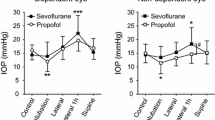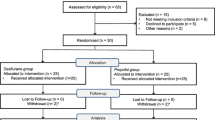Abstract
Purpose
To investigate the agreement between the intraocular pressure (IOP) measurements in the awake condition and under different stages of general inhalational anesthesia using sevoflurane in both glaucomatous and normal children.
Methods
A prospective study was performed on 43 glaucomatous children and 30 age-matched controls. Baseline IOP of one eye was measured immediately before general anesthesia using Perkins tonometer and then re-measured under light, intermediate, and deep anesthesia, and then after intubation. Depth of anesthesia was determined using bispectral index pediatric sensor. The agreement between the IOP measurements before and during different stages of anesthesia was analyzed using Bland–Altman plots. Systematic and proportionate deviations between the IOP measurements were analyzed.
Results
The mean age was 58.6 ± 41.99 months. The mean IOP was significantly lower at all stages of anesthesia in both groups. The coefficient of variation was over 20% in all measurements under anesthesia. For all IOP measurements during anesthesia, the limits of agreement were > 7 mmHg difference in the control group and > 20 mmHg in the glaucomatous group. The best agreement was with the IOP measurement after intubation (mean limit of agreement of -1.4 mmHg, 1.96 s range, −8.8–6 mm Hg) in the control group and with the IOP measurement under intermediate anesthesia (mean limit of agreement of −4.2 mmHg, 1.96 s range, −15.1–6.8 mm Hg) in the glaucomatous group.
Conclusions
Inhalational anesthesia has variable effects on IOP measurement at all stages of anesthesia. Caution should be taken when extrapolating the true IOP from these measurements.



Similar content being viewed by others
Data availability
Data are available from the corresponding author upon request.
References
Bresson-Dumont H (2009) Intraocular pressure measurement in children. J Fr Ophthalmol 32(3):176–178. https://doi.org/10.1016/j.jfo.2009.03.008
Mikhail M, Sabri K, Levin AV (2017) Effect of anesthesia on intraocular pressure measurement in children. Surv Ophthalmol 62:648–658. https://doi.org/10.1016/j.survophthal.2017.04.003
Pınar HU, Kaşdoğan ZEA, Başaran B, Çöven İ, Karaca Ö, Doğan R (2018) The effect of spinal versus general anesthesia on intraocular pressure in lumbar disc surgery in the prone position: A randomized, controlled clinical trial. J Clin Anesth 46:54–58. https://doi.org/10.1016/j.jclinane.2018.01.026
Yassin HM, Abdel Moneim AT, Mostafa Bayoumy AS, Bayoumy HM, Taher SG (2017) The influence of two different doses of magnesium sulfate on intraocular pressure variations after injection of succinylcholine and endotracheal intubation: a prospective, randomized, parallel three-arm, double-blind, placebo-controlled clinical trial. Anesth Essays Res 11:969–975. https://doi.org/10.4103/aer.AER_35_17
Yamada MH, Takazawa T, Iriuchijima N, Horiuchi T, Saito S (2016) Changes in intraocular pressure during surgery in the lateral decubitus position under sevoflurane and propofol anesthesia. J Clin Monit Comput 30:869–874. https://doi.org/10.1007/s10877-015-9787-3
Gofman N, Cohen B, Matot I, Cattan A, Dotan G, Stolovitch C, Ela-Dalman N (2017) Do intraocular pressure measurements under anesthesia reflect the awake condition? J Glaucoma 26:299–302. https://doi.org/10.1097/ijg.0000000000000355
Park JT, Lim HK, Jang KY, Um DJ (2013) The effects of desflurane and sevoflurane on the intraocular pressure associated with endotracheal intubation in pediatric ophthalmic surgery. Korean J Anesthesiol 64:117–122. https://doi.org/10.4097/kjae.2013.64.2.117
Sahin A, Tufek A, Cingu AK, Caca I, Tokgoz O, Balsak S (2012) The effect of I-gel TM airway on intraocular pressure in pediatric patients who received sevoflurane or desflurane during strabismus surgery. Paediatr Anaesth. 22:772–775. https://doi.org/10.1111/j.1460-9592.2012.03854.x
Blumberg D, Congdon N, Jampel H, Gilbert D, Elliott R, Rivers R et al (2007) The effects of sevoflurane and ketamine on intraocular pressure in children during examination under anesthesia. Am J Ophthalmol. 143:494–499. https://doi.org/10.1016/j.ajo.2006.11.061
Beekoo D, Yuan K, Dai S, Chen L, Di M, Wang S et al (2019) Analyzing electroencephalography (EEG) waves provides a reliable tool to assess the depth of sevoflurane anesthesia in pediatric patients. Med Sci Monit. https://doi.org/10.12659/MSM.915640
Sciusco A, Standing JF, Sheng Y, Raimondo P, Cinnella G, Dambrosio M (2017) Effect of age on the performance of bispectral and entropy indices during sevoflurane pediatric anesthesia: a pharmacometric study. Paediatr Anaesth 27:399–408. https://doi.org/10.1111/pan.13086
Sargin M, Uluer MS, Ozmen S (2015) The effects of bispectral index monitoring on hemodynamics and recovery profile in developmentally delayed pediatric patients undergoing dental surgery. Paediatr Anaesth 25:950–955. https://doi.org/10.1111/pan.12692
Musizza B, Ribaric S (2010) Monitoring the depth of anaesthesia. Sensors (Basel) 10:10896–10935. https://doi.org/10.3390/s101210896
Giavarina D (2015) Understanding Bland–Altman analysis. Biochem Med. https://doi.org/10.11613/BM.2015.015
Gleason CR, Ji QC, Wickremsinhe ER (2020) Evaluation of correlation between bioanalytical methods. Bioanalysis 12(6):419–426. https://doi.org/10.4155/bio-2020-0019
El Sayed Y, Esmael A, Mettias N, El Sanabary Z, Gawdat G (2019) Factors influencing the outcome of goniotomy and trabeculotomy in primary congenital glaucoma. Br J Ophthalmol. https://doi.org/10.1136/bjophthalmol-2018-313387
Sihota R, Tuli D, Dada T, Gupta V, Sachdeva MM (2006) Distribution and determinants of intraocular pressure in a normal pediatric population. J Pediatr Ophthalmol Strabismus 43:14–18. https://doi.org/10.3928/01913913-20060101-01
Oberacher-Velten I, Prasser C, Rochon J, Ittner KP, Helbig H, Lorenz B (2011) The effects of midazolam on intraocular pressure in children during examination under sedation. Br J Ophthalmol 95:1102–1105. https://doi.org/10.1136/bjo.2009.173641
Ausinsch B, Rayburn RL, Munson ES, Levy NS (1976) Ketamine and intraocular pressure in children. Anesth Analg 55:773–775. https://doi.org/10.1213/00000539-197611000-00005
Shah N, Jethani JN, Dave P, Chanpura R (2015) Effect of various anesthetic medication on intraocular pressure (IOP) in children. Best free papers, 73rd AIOC. New Delhi
Esmael A, Ismail YM, Elhusseiny AM, Fayed AE, Elhilali HM (2019) Agreement profiles for rebound and applanation tonometry in normal and glaucomatous children. Eur J Ophthalmol 29:379–385. https://doi.org/10.1177/1120672118795060
Samuels BC, Hammes NM, Johnson PL, Shekhar A, McKinnon SJ, Allingham RR (2012) Dorsomedial/Perifornical hypothalamic stimulation increases intraocular pressure, intracranial pressure, and the translaminar pressure gradient. Invest Ophthalmol Vis Sci 53:7328–7335. https://doi.org/10.1167/iovs.12-10632
Scheiermann P, Herzog F, Siebenhofer A, Strametz R, Weberschock T (2018) Intravenous versus inhalational anesthesia for pediatric inpatient surgery: a systematic review and meta-analysis. J Clin Anesth 49:19–25. https://doi.org/10.1016/j.jclinane.2018.05.014
Kim EH, Song IK, Lee JH, Kim HS, Kim HC, Yoon SH, Jang YE, Kim JT (2017) Desflurane versus sevoflurane in pediatric anesthesia with a laryngeal mask airway: a randomized controlled trial. Medicine (Baltimore) 96:e7977. https://doi.org/10.1097/MD.0000000000007977
Brioni JD, Varughese S, Ahmed R, Bein B (2017) A clinical review of inhalation anesthesia with sevoflurane: from early research to emerging topics. J Anesth 31:764–778. https://doi.org/10.1007/s00540-017-2375-6
Duman A, Ogün CO, Okesli S (2001) The effect on intraocular pressure of tracheal intubation or laryngeal mask insertion during sevoflurane anaesthesia in children without the use of muscle relaxants. Paediatr Anaesth 11:421–424. https://doi.org/10.1046/j.1460-9592.2001.00692.x
Ismail SA, Bisher NA, Kandil HW, Mowafi HA, Atawia HA (2011) Intraocular pressure and haemodynamic responses to insertion of the i-gel laryngeal mask airway or endotracheal tube. Eur J Anaesthesiol 28:443–448. https://doi.org/10.1097/EJA.0b013e328345a413
Serafino M, Villani E, Lembo A, Rabbiolo G, Specchia C, Trivedi RH, Nucci P (2020) A comparison of Icare PRO and Perkins tonometers in anesthetized children. Int Ophthalmol 40(1):19–29. https://doi.org/10.1007/s10792-019-01143-3
van der Walt JG, Roodt F, Tinley C (2018) How does sevoflurane induction, followed by a ketamine maintenance infusion, affect intraocular pressure? establishment of an anaesthetic protocol for paediatric glaucoma examinations under anaesthesia. Br J Ophthalmol 102:902–905. https://doi.org/10.1136/bjophthalmol-2017-310872
Author information
Authors and Affiliations
Corresponding author
Ethics declarations
Conflicts of interest
The author declared that there is no conflict of interest.
Ethical Approval
The study protocol was approved by Cairo University Research Ethics Committee. The study and data collection conformed to all local laws and were compliant with the principles of the Declaration of Helsinki.
Consent to participate
Written informed consent was obtained from the guardians of all children included in the study.
Consent for publication
All authors approved the final version of the manuscript.
Additional information
Publisher's Note
Springer Nature remains neutral with regard to jurisdictional claims in published maps and institutional affiliations.
Supplementary Information
Below is the link to the electronic supplementary material.
10792_2021_1800_MOESM1_ESM.tif
Deming regression analysis showing the systematic bias, represented by the intercept, and the proportionate bias, represented by the slope, between the IOP measured under awake condition and that measured under different stages of anesthesia in the control group (TIF 1239 KB)
10792_2021_1800_MOESM2_ESM.tif
Deming regression analysis showing the systematic bias, represented by the intercept, and the proportionate bias, represented by the slope, between the IOP measured under awake condition and that measured under different stages of anesthesia in the glaucomatous group (TIF 1318 KB)
Rights and permissions
About this article
Cite this article
Samy, E., El Sayed, Y., Awadein, A. et al. Effect of general inhalational anesthesia on intraocular pressure measurements in normal and glaucomatous children. Int Ophthalmol 41, 2455–2463 (2021). https://doi.org/10.1007/s10792-021-01800-6
Received:
Accepted:
Published:
Issue Date:
DOI: https://doi.org/10.1007/s10792-021-01800-6




